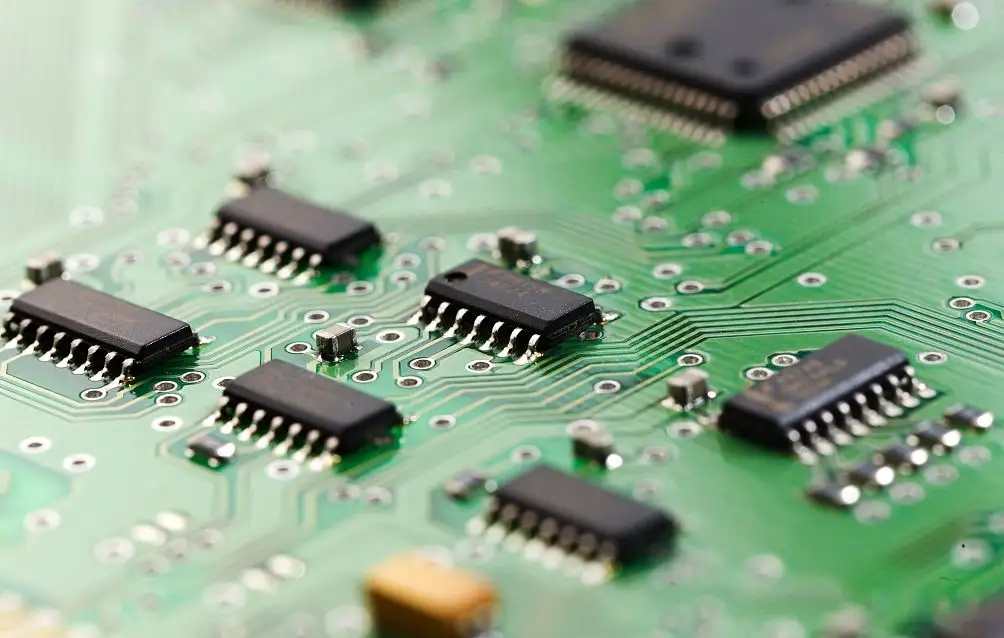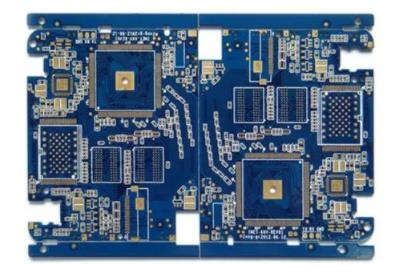
Rigid-flex board applICation in PCB design
The trend of PCB design is to develop in the direction of thinness and lightness. In addition to high-density circuit board design, there is an important and complex field such as the three-dimensional connection assembly of flex-rigid PCB . Rigid-flex board is also calLED rigid-flex board. With the birth and development of FPC, the new product of rigid-flex circuit board (flex-rigid board) has gradually been widely used in various occasions. Therefore, the flexible and rigid board is a flex-rigid PCB board and a traditional rigid circuit board, which are combined according to the relevant process requirements through many processes to form a circuit board with both FPC characteristics and PCB characteristics. It can be used in some products with special requirements, including a certain flexible area and a certain rigid area, which is of great help to save the internal space of the product, reduce the volume of the finished product, and improve the performance of the product.
Material of flexible board
As the saying goes: "If a worker wants to do a good job, he must first sharpen his tool", so it is very important to make full preparations when considering the design and production process of a flexible and rigid board. However, this requires certain professional knowledge and an understanding of the required material properties. The material selected for the rigid-flex board directly affects the subsequent production process and its performance.
Everyone is familiar with the material of rigid board (Rigid), and FR4 type material is often used. However, the rigid board materials used for soft-rigid bonding also need to take into account many requirements. It needs to be suitable for adhesion and good heat resistance, so as to ensure that the rigid-flexible joint part has the same stretch without deformation after being heated. General manufacturers use resin series rigid board materials.
For flexible board (Flex) materials, choose the substrate and cover film with less dimensional expansion and contraction. Generally, materials made of harder PI are used, and some are produced directly using glue-free substrates. The soft board material is as follows:
Base Material: FCCL (Flexible copper Clad Laminate)
Polyimide PI. Polymide: Kapton (12.5um/20um/25um/50um/75um). Good flexibility, high temperature resistance (long-term use temperature of 260 ° C, short-term resistance to 400 ° C), high hygroscopicity, good electrical and mechanical properties, good tear resistance. Good weather resistance and chEMIcal resistance, good flame retardancy. Polyesterimide (PI) is the most widely used. 80% of them are made by DuPont in the United States.
Polyester PET. Polyester (25um/50um/75um). Inexpensive, flexible and tear-resistant. Good mechanical and electrical properties such as tensile strength, good water resistance and hygroscopicity. However, the shrinkage rate after heating is large, and the high temperature resistance is not good. Not suitable for high temperature soldering, the melting point is 250°C, and it is rarely used.
Coverlay
The main function of the cover film is to protect the circuit from moisture, pollution and soldering. Cover film thickness From1/2mil to 5 mils (12.7 to 127um).

Conductive layer (ConducTIve Layer) points rolled copper (Rolled Annealed Copper), electrolytic copper (Electrodeposited Copper) and silver sputtering / sputtering (Silver Ink) these methods. Among them, the crystal structure of electrolytic copper is rough, which is not conducive to the yield of fine lines. Calendered copper has a smooth crystal structure, but poor adhesion to the base film. Distinguished and rolled copper foil can be distinguished in appearance. The electrolytic copper foil is copper red, and the rolled copper foil is gray-white.
Auxiliary materials and reinforcing plates (AddiTIonal Material & Stiffeners). A hard material that is additionally pressed on the local area of the flexible board for welding components or adding reinforcement for installation. Reinforcing film can be reinforced with FR4, resin board, pressure-sensitive adhesive, steel sheet and aluminum sheet.
No-flow/low-flow adhesive prepreg (Low Flow PP). For the lamination of rigid and flexible boards (Rigid and Flex Connection), usually very thin PP. Generally, there are 106 (2mil), 1080 (3.0mil/3.5mil), 2116 (5.6mil) specifications.
Structural form of rigid-flex board
The rigid-flex PCB board is to stick one or more rigid layers on the flexible board, and the circuit on the rigid layer and the circuit on the flexible layer are connected to each other through metallization. Each rigid-flex board has one or more rigid areas and one flexible area. Shown below is a SIMple combination of rigid and flexible boards with more than one layer.
In addition, the combination of one flexible board and several rigid boards, and the combination of several flexible boards and several rigid boards, use drilling, plated-through holes, and lamination process methods to achieve electrical interconnection. According to the design needs, the design concept is more suitable for the installation and debugging of the device and the welding operation. To ensure better use of the advantages and flexibility of rigid-flex boards. This situation is more complicated, with more than two layers of wires. As follows:
Lamination is to laminate copper foil, P sheet, memory flexible circuit, and outer rigid circuit into a multi-layer board. Lamination of rigid-flex boards differs from lamination of only flex boards or lamination of rigid boards. The minutes consider the deformation of the flexible board during the lamination process and the surface flatness of the rigid board. Therefore, in addition to material selection, it is necessary to consider the appropriate thickness of the rigid board in the design process, so as to ensure that the expansion and contraction rate of the rigid-flexible part is consistent and will not warp. Experiments show that the thickness of 0.8~1.0mm is more suitable. At the same time, pay attention to placing vias at a certain distance between the rigid board and the flexible board from the joint part, so as not to affect the rigid-flex joint part.
Rigid-flex board production process
We all know that the rigid-flex board is a combination of FPC and PCB . The production of the rigid-flex board should have both FPC production equipment and PCB processing equipment. First, the electronic engineer draws the circuit and shape of the flexible board according to the needs, and then sends it to the factory that can produce the flexible board. The CAM engineer processes and plans the relevant documents, and then arranges the FPC production line. FPC and PCB production lines are required to produce PCBs. After these two soft boards and hard boards come out, according to the planning requirements of electronic engineers, FPC and PCB are seamlessly pressed by a pressing machine, and then after a series of detailed links, the final process is soft. Hard-bonded board.
Take Motorola 1+2F+1 Mobile Display&Side Keys, a 4-layer board (two-layer hard board and two-layer soft board) as an example. The plate making requirements of this board are HDI design, and the BGA spacing is 0.5mm. The thickness of the flex board is 25um with IVH (IntersTItial Via Hole partial interlayer via hole) hole design. Whole board thickness: 0.295+/-0.052mm. The inner layer LW/SP is 3/3mil.
Design rule considerations for rigid-flex version
Rigid-flex boards are much more complicated in design than traditional PCB designs, and there are many places to pay attention. In particular, the rigid-flex transition area, as well as related design aspects such as traces and vias, need to follow the requirements of the corresponding design rules.
1. Via location
In the case of dynamic use, especially when the flexible board is often bent, the vias on the flexible board should be avoided as much as possible, and these vias are easily damaged and broken. However, holes can still be punched in the reinforced area of the soft board, but it should also be avoided near the edge of the reinforced area. Therefore, a certain distance from the bonding area should be avoided when punching holes in the design of the flex-rigid board. As shown below.
For the distance requirements between the via and the soft and hard bonding area, the rules to be followed in the design are:
A distance of at least 50mil should be kept, and at least 70mil is required for high reliability applications.
Most processors will not accept a limit distance below 30mil.
Follow the same rules for vias on flex boards.
This is one of the most important design rules for flex-rigid boards that must be followed.
2. Design of pads and vias
The pads and vias should win the maximum value when they meet the electrical requirements. A smooth transition line is used at the connection between the pad and the conductor to avoid right angles. Independent pads should be added with toes to strengthen the support.
In flex-rigid Board Designs, vias or pads can easily be damaged. Rules to follow to reduce this risk:
The soldering flux layer of the pad or via exposes the copper ring, the bigger the better.
Add teardrops as much as possible to the vias to increase the mechanical support.
Add disc toe for reinforcement.
3. Trace Design
If there are traces on different layers in the flex area (Flex), try to avoid that one wire is on the top layer and the other wire is on the same path on the bottom layer. In this way, when the flexible board is bent, the force of the upper and lower copper layers of the wiring is inconsistent, which is easy to cause mechanical damage to the circuit. Instead, they should be staggered, arranging the paths crosswise. As shown below.
The routing design in the flex zone (Flex) requires that it is best to take a circular arc rather than an angle. Contrary to the suggestion in the Rigid section. In this way, part of the circuit of the flexible board can be protected from being easily damaged when it is bent. The lines should also avoid sudden expansion or contraction, and use teardrop-shaped arc connections between thick and thin lines.
4. Copper design
For the flexible bending of the reinforced flexible board, it is best to use a mesh structure for the copper layer or the plane layer. However, for impedance control or other applications, the electrical quality of the mesh structure is unsatisfactory. Therefore, the designer needs to make a reasonable judgment according to the design requirements in the specifIC design, whether to use mesh copper or solid copper. However, for the waste area, design as much solid copper as possible. As shown below.
5. The distance between drilling and copper
This distance refers to the distance between a hole and the copper sheet, which we call "hole-to-copper distance". Flex board materials are different from those used for hard boards, so tight hole-to-copper distances are difficult to handle. Generally speaking, the standard hole copper distance should be 10mil.
For the rigid-flexible area, the two most important distances must not be ignored. One is the drill to copper distance mentioned here, which follows the minimum standard of 10mil. The other is the distance from the hole to the edge of the flexible board (Hole to Flex), which is generally recommended to be 50mil.
6. Design of the rigid-flexible area
In the rigid-flexible bonding area, the flexible board is preferably designed to be connected to the rigid board in the middle of the stack. The vias of the flex board are considered buried holes in the rigid-flexible area. The points that need to be paid attention to in the rigid-flexible area are as follows:
The line should transition smoothly, and the direction of the line should be perpendicular to the direction of the bend.
The wires should be evenly distributed throughout the bend area.
The width of the wire should be maximized throughout the bend area.
The rigid-flex transition zone should not be designed with PTH as much as possible.
7. Bending radius of bending zone of rigid-flexible joint plate
The flex-bend zone of the rigid-flex board shall be able to withstand 100,000 flexures without opening, shorting, performance degradation, or unacceptable delamination. The flexural resistance is measured by special equipment or an equivalent instrument. The tested sample should meet the requirements of relevant technical specifications. In design, the bending radius should be as shown in the figure below as a reference. The design of the bending radius should be related to the thickness of the soft board in the flexible bending zone and the number of layers of the soft board. A simple reference standard is R=WxT. T is the total thickness of the soft board. The single-sided board W is 6, the double-sided board 12, and the multi-layer board 24. Therefore, the minimum bending radius of the single-sided board is 6 times the board thickness, the double-sided board is 12 times the board thickness, and the multi-layer board is 24 times the board thickness. All should not be less than 1.6mm.
In conclusion, for the design aspects of flex-rigid boards, of particular importance is the design of flexible PCB . The design of flexible boards requires consideration of different materials, thicknesses and combinations of substrates, adhesive layers, copper foils, cover layers and reinforcements and surface treatments of flexible boards, as well as their properties, such as peel strength, flex resistance bending properties, chemical properties, working temperature, etc. Particular consideration is given to the assembly and specific application of the designed flexboard. Specific design rules in this regard can refer to IPC standards: IPC-D-249 and IPC-2233.
In addition, for the processing accuracy of the soft board, the foreign processing accuracy: line width: 50μm, aperture: 0.1mm, and the number of layers is more than 10 layers. Domestic: Line width: 75μm, aperture: 0.2mm, 4 layers. These all need to be understood and referenced in the specific design.Rigid-flex rigid-flex board application in PCB design.
然后
联系
电话热线
13410863085Q Q

微信

- 邮箱











